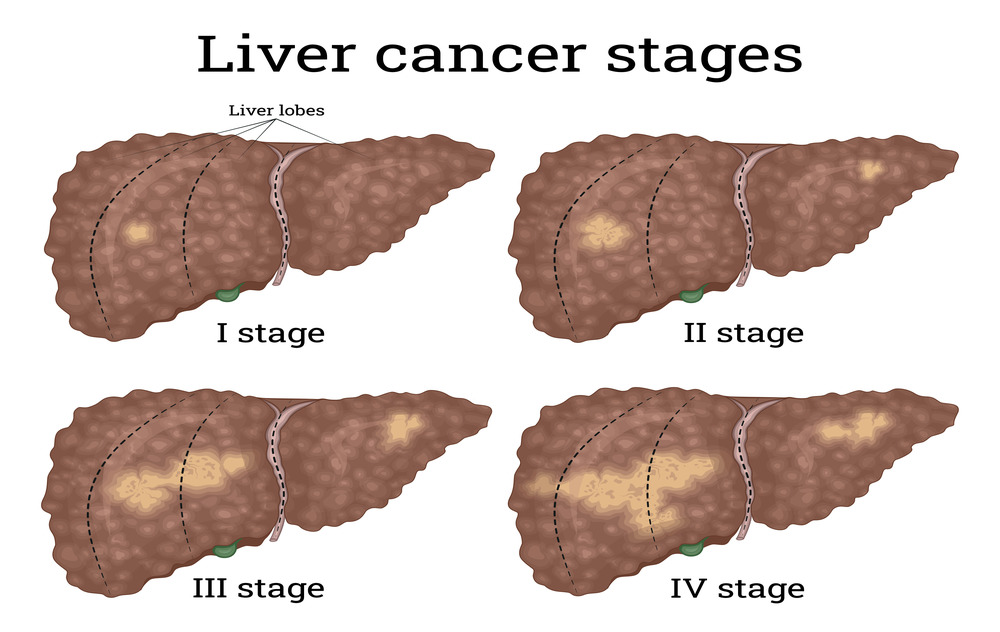After a patient is diagnosed with liver cancer, it is very important to know whether the cancer is limited to the liver or has spread to other organs. This process is called staging. The stage of cancer provides critical information about the seriousness of the disease, including the expected survival (although this is not always correct) and the therapeutic options that are available.
What Causes Liver Cancer?
Liver cancer occurs when the DNA of liver cells develops mutations. The DNA of a cell is the material that contains the instructions for all of your body’s chemical processes. As a result of these DNA mutations, cells may grow out of control and eventually form a tumor, which is a mass of malignant cells. In some cases, such as with chronic hepatitis infections, the cause of liver cancer is known. However, liver cancer can also occur in people who have no underlying illnesses, and the cause remains unknown.
Factors that may increase your risk of developing liver cancer include:
- Chronic infection with HBV or HCV
- Cirrhosis
- Certain inherited liver diseases, including hemochromatosis and Wilson’s disease
- Diabetes
- Nonalcoholic fatty liver disease
- Exposure to aflatoxins, which are poisons produced by molds that grow on poorly-stored crops
- Excessive alcohol consumption
What Are the Signs and Symptoms of Liver Cancer?
People with liver cancer often experience no symptoms, especially when the tumor is detected early through a screening program. However, when symptoms or signs of liver cancer do occur, they may include the following:
- A lump below your rib cage
- Pain on the right side of your abdomen or near your right shoulder
- Abdominal swelling or bloating
- Jaundice (a disease that causes skin and eyes to yellow)
- Unexplained weight loss, nausea, or loss of appetite
- Fatigue
- Dark-colored urine
- Pale/chalky stools
- Unexplained or unintentional weight loss
- Nausea and vomiting
Many of the signs and symptoms above may be caused by conditions other than liver cancer. However, if you notice any of these symptoms, it is important to consult with your doctor for an accurate diagnosis.
How is Liver Cancer Staged?
Although there are several staging systems for primary liver cancer, known as hepatocellular carcinoma or HCC, the one that is most used in the United States is the Barcelona Clinic Liver Cancer system (BCLC) which consists of 5 stages – stage 0, A, B, C, and D – where each stage is determined using the following factors:
- The number and size of tumors in the liver
- The patient’s general health (performance status or PS)
- The patient’s liver function (Child-Pugh score)
What is the Performance Status (PS)?
The Performance status (PS) is a standard measure of a person’s ability to perform ordinary tasks and complete daily activities. The BCLC staging system uses the Eastern Cooperative Oncology Group (ECOG) scale:
- PS 0 – you are fully active, as you were before your illness
- PS 1 – you can’t carry out heavy physical work, but can do anything else
- PS 2 – you are up and about more than half the day. You can look after yourself but can’t work
- PS 3 – you are in bed or a chair for more than half the day. You need help to look after yourself
- PS 4 – you are in bed or a chair all the time and need complete care
What is the Child-Pugh Score?
The Child-Pugh score evaluates how well the liver is performing its tasks and therefore is an accurate reflection of the liver function. The score is based on the following measures:
- Bilirubin levels in the blood
- Albumin levels in the blood
- How quickly the blood clots
- If there is fluid in the abdomen
- If the liver cancer is impacting brain function
Each one is given a number score, and based on that score, people fall into 1 of 3 classes:
- class A means the liver is working normally
- class B means mild to moderate damage
- class C means there is severe liver damage
Liver Cancer Stages
The BCLC staging system consists of 5 stages:
Stage 0 (very early stage): The tumor is less than 2cm, patients feel well, and their liver is working normally.
Stage A (early stage): There is a single tumor of any size, or up to 3 tumors each less than 3 cm. Patients feel well, are active, and their liver is functioning fine.
Stage B (intermediate stage): There are many tumors in the liver, but the patients still feel well, and their liver is also functioning normally.
Stage C (advanced stage): The cancer has spread into the blood vessels, lymph nodes, or other distant organs. Patients do not feel well and are less active, but their liver is still functioning relatively normally.
Stage D (terminal stage): Patients have severe liver damage, are not feeling well, and need help to look after themselves. This stage carries the worst prognosis and only supportive measures are recommended.
Cutting Edge Liver Cancer Treatments in New York
At USA Oncology Centers, our goal is to provide our patients with effective liver cancer treatments in New York that will improve their chances of survival as well as their quality of life. We work with you at every step to determine the optimal treatment plan.
Our doctors are experts in providing minimally invasive treatments for both primary and secondary liver cancer. These treatments include the following:
At USA Oncology Centers, our patients always come first. To learn more about our treatment options, call us at 855.870.4747 or schedule an appointment with an interventional oncologist today.

